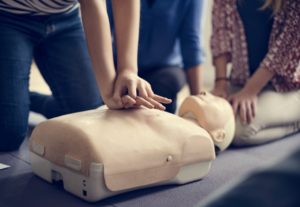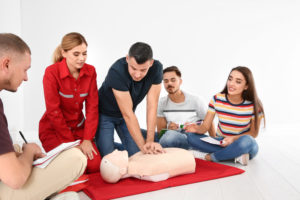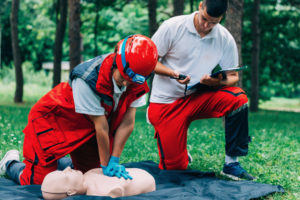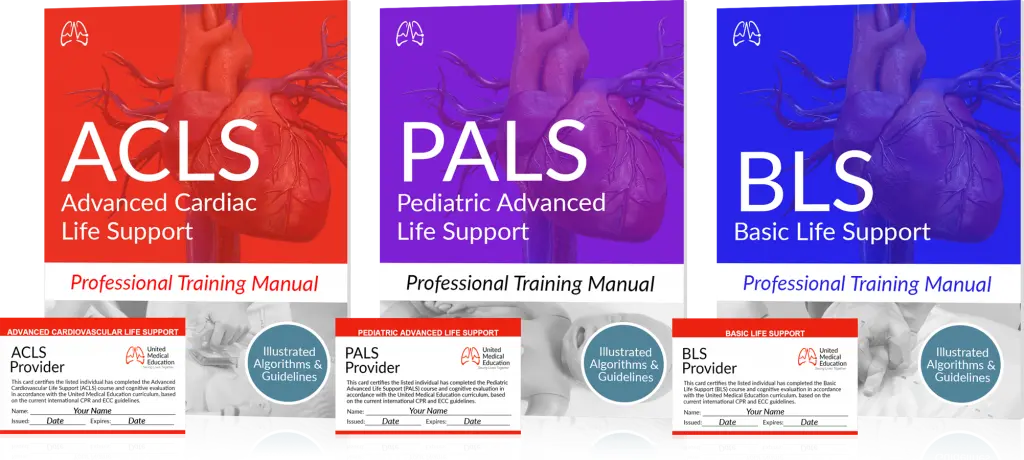My friend Emily, an experienced nurse, once told me about a heart-stopping situation she faced at a public park. She was off-duty, enjoying a sunny afternoon when a nearby soccer match turned into a crisis. A player collapsed, showing clear signs of cardiac arrest. Emily sprang into action, initiating CPR while someone called for an ambulance. Using the AED available at the park, she managed to restore the player’s heartbeat. As the ambulance whisked him away, Emily was left with the profound realization of how crucial her CPR and AED training had been in saving a life that day.
Emergency Medical Technicians (EMTs) represent the front line of medical response in moments of crisis. Every day, they face high-pressure situations where their actions directly affect people’s lives. An EMT’s ability to remain composed, make rapid decisions, and implement emergency procedures can mean the difference between life and death. Among these procedures, CPR, AED use, and First Aid are vital skills that every EMT must master.
The Lifesaving Power of CPR
Cardiopulmonary Resuscitation (CPR) is more than just a medical procedure—it’s a ray of hope for those in the grip of a cardiac emergency. When the heart ceases its essential rhythm, CPR serves as a bridge of life until more advanced medical help can arrive. CPR involves chest compressions and rescue breaths that keep oxygen circulating to the brain, delaying damage and preserving life.
However, executing CPR requires not just knowledge, but expertise. This expertise comes from training and repeated practice until the procedure becomes muscle memory. A well-executed CPR can double, even triple, a cardiac arrest victim’s chances of survival, reinforcing the importance of CPR certification for EMTs.
AEDs: Shocking Hearts Back to Life
While CPR can keep oxygen flowing, it cannot restart a heart that’s ceased to beat. This is where Automated External Defibrillators (AEDs) come into play. AEDs deliver controlled electric shocks to the heart, potentially restarting its natural rhythm and effectively saving a life.
Understanding when and how to use an AED is critical for EMTs. Misuse can lead to further complications, emphasizing the need for professional training and certification in AED use. Given the time-sensitive nature of cardiac emergencies, EMTs certified in AED use can ensure the device is used promptly and correctly, greatly enhancing a patient’s chances of survival.
First Aid: EMTs’ First Response to a Variety of Emergencies
In the face of a crisis, from car accidents to sudden allergic reactions, First Aid is often the primary defense. EMTs need the ability to assess a situation quickly, stabilize patients, and provide immediate relief. This initial treatment can slow the progression of an injury and buy precious time until further medical assistance arrives.
Therefore, First Aid certification is a necessity for EMTs. It provides them with a comprehensive understanding of different medical emergencies and equips them with the skills to manage these situations effectively, preventing further harm and potentially saving lives.
The Intersection of EMT Training and Real-Life Scenarios
EMT training isn’t limited to theory. Instead, it closely mirrors real-life situations that professionals may encounter. Be it a teenager experiencing a sudden cardiac arrest during a basketball game or an elderly person suffering a fall at home, EMTs are often the first on the scene. Their ability to swiftly administer CPR, use an AED, or provide First Aid can significantly impact the outcome. Thus, professional training and certification in these areas are essential for ensuring the effectiveness of EMTs in real-world scenarios.
The Impact of Comprehensive Training on Patient Outcomes
Evidence supporting the importance of CPR, AED, and First Aid training is plentiful. Studies show that immediate and effective CPR can significantly improve survival rates following cardiac arrest. Similarly, using an AED within the first 3-5 minutes can increase the chances of survival by up to 70%. These figures underline how a well-trained EMT can influence patient outcomes positively.
Free Training and Certification Opportunities at United Medical Education
Recognizing the critical role that EMTs play, United Medical Education offers comprehensive training and certification in CPR, AED, and First Aid. Additionally, we offer free PALS (Pediatric Advanced Life Support) training for those who build a student account, ensuring that every EMT has access to these life-saving skills. Our practice exams also aid in preparing students for the PALS final exam, ensuring they are equipped to face real-world scenarios.
Enhancing EMT Skills with Regular Training
While initial training is crucial for EMTs, it’s equally important to ensure regular refreshers and updates. Medical techniques and technologies are continually advancing, and EMTs must stay current to provide the best care. Regular training ensures they can efficiently perform CPR, AED use, and First Aid, even under stressful conditions.
At United Medical Education, we advocate for continuous learning and skills enhancement. We offer advanced courses and updates on CPR, AED, and First Aid, ensuring EMTs are equipped with the most current life-saving strategies.
The Bigger Picture: Community Impact
EMTs with adequate training not only save lives but also inspire confidence within the community. Their knowledge and skills reassure people that help is always available, promoting a sense of safety and security. Moreover, EMTs can pass on their knowledge, teaching community members basic life-saving procedures, thereby amplifying their impact.
Looking Toward the Future
As the medical field continues to evolve, EMT training must adapt. CPR, AED, and First Aid training will always be the cornerstone of EMT education, but as we look to the future, we also see the need for additional skills. For instance, as telemedicine grows, EMTs might require training in virtual patient interactions.
At United Medical Education, we are ready to meet these challenges. We are dedicated to providing the highest quality training for EMTs, preparing them for the ever-changing landscape of emergency medical services.
Conclusion: The Lifesaving Power of EMT Training
The role of an EMT is both challenging and rewarding. As they stand on the frontlines of healthcare, their skills in CPR, AED use, and First Aid can change—and save—lives. Their quick actions, often taken in the face of chaos and stress, reflect their proficiency and the high quality of their training.
Organizations like United Medical Education play a significant role in this process, providing comprehensive, up-to-date training programs that ensure EMTs are equipped to face any emergency. With the right training, every EMT can become a life-saving professional, demonstrating the powerful impact of their role in our communities.
We invite you to visit our website and learn more about the training and certification programs we offer. Together, we can empower our EMTs and contribute to a safer, healthier future for all.








